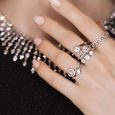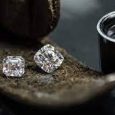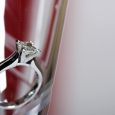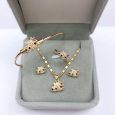When you hear “fracture-filled diamonds”, it means that the cracks or fractures of the diamonds have already been filled to improve and bring back their lost brilliance. Even if fracture filling provides such an enhancement, fracture-filled diamonds are usually less durable and less valuable.

History
In 1982, Zvi Yehuda developed the fracture filling process in diamonds. The diamond cutter and inventor filled the long cracks in the diamonds with liquified glass, which enhances the clarity of the stones. When the 90s arrived, fracture-filled diamonds started to appear in large numbers.
Process and Purpose
During the process, the glass provides a refractive index like that of a diamond. Because of this, fractures become less detectable. Fracture filling is usually performed under ample pressure and heat to push the molten glass into the diamond’s fractures. As a result, the diamond’s clarity improves by one grade. The extremely thin film of glass does not affect the diamond’s weight and color.
Diamonds with tiny cracks are the ones that ultimately benefit from fracture filling. The process doesn’t have the same effect on large cracks. Take note that many precious stones like diamonds have tiny cracks, often referred to as feathers by retailers. These inclusions don’t threaten the life span or integrity of the diamond. Yet, they must be treated to improve the quality of the stone.
Fracture-filled diamonds are controversial because the filling usually dislodges or gets damages during repair or cleaning. Fracture filling is a treatment that’s usually very delicate. It requires a highly experienced diamond grader to find out if the stone has been fracture-filled.
By reducing the perceptibility of the separations, such as fractures and cleavages, that reach the stone’s surface, fracture filling can alter the visible clarity from SI to VS, but it can also provide imperfect diamonds a salable, desirable appearance.

Honesty Upon Purchase
Esteemed members of the World Federation of Diamond Bourses and the International Diamond Manufacturers Association authorized resolutions that selling fracture-filled diamonds deliberately without declaring that it was subjected to the treatment is an act of conduct unbecoming of a member and fraud.
GIA encountered diamond fracture-filling in January 1987 when an associate submitted a number of these diamonds for evaluation. After a thorough examination, GIA disseminated a press release on August 14, 1987, to notify the diamond trade about the procedure.
Effectiveness of Filling
It was earlier mentioned that the end result of fracture filling is the enhanced clarity of the diamond. This treatment originates from the oiling of emeralds, which has been used since the time of the ancient Roman Empire. The method of filling the fractures with oil makes the inclusions less obvious as opposed to just letting the air fill them.
Diamond fracture-filling is the same. A clear material with an index of refraction, similar to a diamond’s, replaces the air that usually fills the inclusions. As a result, there is a less obvious break, which then improves the general look of the diamond to the untrained eye. Thus, came the birth of fracture-filled diamonds.

Microscopic Examination Proves It
To the eye of an ordinary person, fracture-filled diamonds can look a bit oily or greasy and a little yellowish. You can see the tinge in many of the stone’s treated areas. This may be caused by the color of the filling itself. An experienced diamond assessor or owner would know that something is off in these filled diamonds. This may hold true to a diamond that has several visible inclusions.
With the help of a microscope (loupe), some features detected can serve as evidence that the stone has been fracture-filled:
Flash Effect
This feature is a common and obvious characteristic of filled cleavages and breaks. The effect happens when a filled diamond is tilted forwards and backward. Interference colors will transform from orange to blue and then orange, in flashes. The compound introduced into the diamond flows through capillary action straight into the diamond’s open areas. This hides the feathery look, related to the inclusions or breaks.
Trapped Bubbles
Thorough microscopic analysis of several stones led to the revelation of flattened gas bubbled confined inside the filling material. Most of the detected bubbles were small and numerous enough to make an inclusion that resembles a fingerprint. Others were conspicuous and large. These bubbles could have been caused by the diminished filling material because of the air trapped in the inclusions and the cooling process.

Advantages of Purchasing a Fracture-Filled Diamond
Fracture-filled diamonds are inexpensive. They make it possible for anyone to buy a cleaner, larger diamond that would never have been affordable to them if they opted for a natural diamond.
Take note that buying a fracture-filled diamond is not a means to get a discount at all. Clients would still have to pay the same price for the stone’s grading before it was treated. The single difference is that the inclusion has been transformed into an invisible one to the untrained eye.

Fracture-filled diamonds are enhanced diamonds that can be the option for many consumers. If the treatment has been done meticulously, then this diamond can be the perfect gift for the right person. Discern first and ask for a declaration of the treatment before you purchase a fracture-filled diamond.















